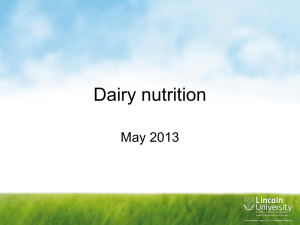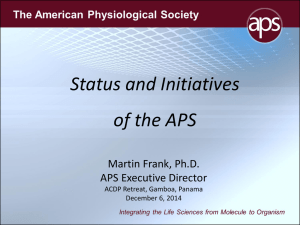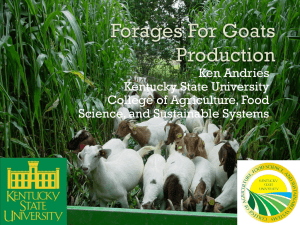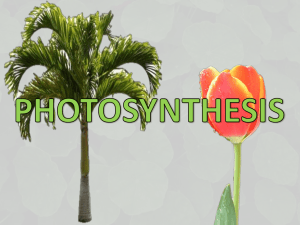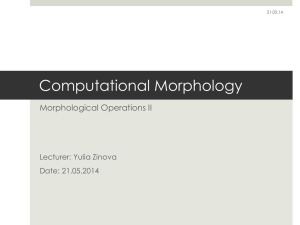Morphology
advertisement
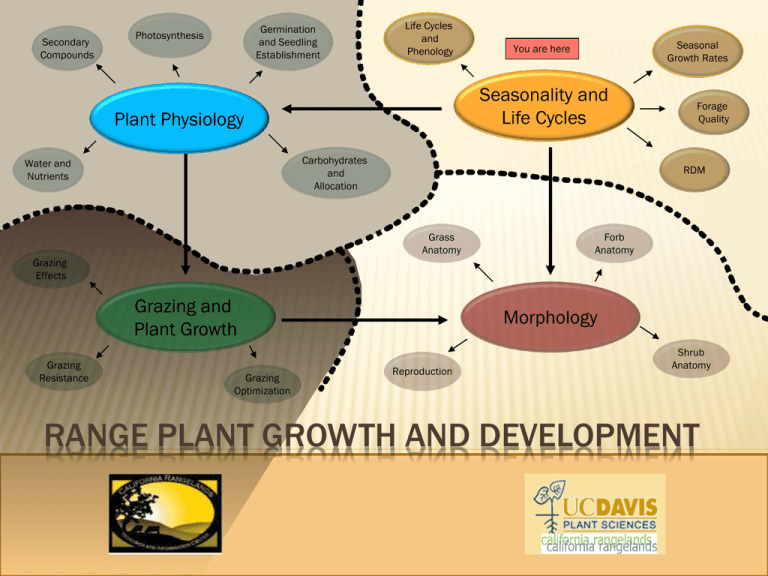
Secondary Compounds Germination and Seedling Establishment Photosynthesis Life Cycles and Phenology Seasonal Growth Rates You are here Seasonality and Life Cycles Plant Physiology Carbohydrates and Allocation Water and Nutrients Forage Quality RDM Grass Anatomy Forb Anatomy Grazing Effects Grazing and Plant Growth Grazing Resistance Grazing Optimization Morphology Reproduction Shrub Anatomy RANGE PLANT GROWTH AND DEVELOPMENT Life Cycles and Phenology You are here Seasonality and Life Cycles Seasonality and Life Cycles Terminology Life Cycles Seasonal growth rates Forage Quality RDM Seasonal Growth Rates Forage Quality RDM READING AND REFERENCES Seasonality and Life Cycles SEASONALITY & LIFE CYCLES The Phenology Handbook, pg 1-15 George et al. 2001. Annual Range Forage Production George and Bell. 2001. Using Stage of Maturity…….. Return to Course Map SEASONALITY & LIFE CYCLES Plant Physiology Return to Course Map Terminology Life Cycles Forage Quality Seasonal growth rates RDM Seasonality and Life Cycles TERMINOLOGY Return to Course Map Annual Perennial Seasonality and Life Cycles TERMINOLOGY Return to Course Map Grass: monocot, most are not woody Forb: dicot, non-woody Shrub Dicot, woody TERMINOLOGY Seasonality and Life Cycles Return to Course Map PHENOLOGY is the science that measures the timing of life cycle events for plants, animals, and microbes, and detects how the environment influences the timing of those events. In the case of flowering plants, these life cycle events, include leaf budburst, first flower, last flower, first ripe fruit, seed set, leaf shedding, others. SEASONALITY & LIFE CYCLES Plant Physiology Return to Course Map Terminology Life Cycles Forage Quality Seasonal growth rates RDM LIFE CYCLES Seasonality and Life Cycles Return to Course Map Seasonality and Life Cycles ANNUAL LIFE CYCLES Return to Course Map Annuals Germination Vegetative Seedling establishment Leaf growth Winter growth is slow Growth accelerates in spring Flowering Seed Set, Drying Dry and Die Seasonality and Life Cycles ANNUAL LIFE CYCLE CALENDAR Return to Course Map N D J F M A M Germination & Seedling Establishment Rapid Vegetative Slow Vegetative Growth Growth J J A S O Little or No Vegetative Growth Tiller Development Flowering Seed Development Seed Set Drying Stems & Leaves Dry & Dead Stems & Leaves Timing of phenological events Seasonality and Life Cycles PERENNIAL LIFE CYCLES Return to Course Map Perennials Lives several years Sexual reproduction Vegetative reproduction Stolons and Rhizomes Winter dormancy Dry season dormancy Vegetative phase Flowering Seed set and dispersal Dormancy PERENNIAL LIFE CYCLE CALENDAR Seasonality and Life Cycles Return to Course Map N D J F M A M J J A Dormant or Slow Vegetative Growth Rapid Vegetative Growth Dormant Dormant Tiller Development Carbohydrate Use Apical Meristems Near Soil Surface S O Slow Vegetative Growth Tiller Development Carbohydrate Storage Flower Stems Elongate Flowering Seed Development Seed Set Drying Stems & Leaves Dry & Dead Stems & Leaves Timing of phenological events PHENOLOGY AND LIFE CYCLES Seasonality and Life Cycles Return to Course Map Phenological events SEASONALITY & LIFE CYCLES Plant Physiology Return to Course Map Terminology Life Cycles Forage Quality Seasonal growth rates RDM PHENOLOGY AND FORAGE QUALITY Seasonality and Life Cycles Return to Course Map Crude protein decreases in annual grasses with stage of maturity (see ANR Publications 8019 and 8022) SEASONALITY & LIFE CYCLES Plant Physiology Return to Course Map Terminology Life Cycles Forage Quality Seasonal growth rates RDM Seasonality and Life Cycles SEASONAL GROWTH RATES Return to Course Map Average Monthly Peak Standing Crop at UC SFREC 3500 lbs/ac 3000 2500 2000 1500 1000 500 0 D1 J1 F1 M1 A1 M1 Peak http://groups.ucanr.org/sierrafoothill/files/67089.pdf Seasonality and Life Cycles SEASONAL GROWTH RATES Return to Course Map Growth rates of perennials in northeastern California 1400 1200 1000 lbs/ac 800 600 400 200 0 1-Feb 1-Mar 1-Apr 1-May 1-Jun 1-Jul SEASONALITY & LIFE CYCLES Plant Physiology Return to Course Map Terminology Life Cycles Seasonal growth rates Forage Quality RDM LITTER: RESIDUAL DRY MATTER Seasonality and Life Cycles Return to Course Map Moderate grazing results in recommended RDM levels Light grazing results in high RDM levels Heavy grazing results in low RDM levels SUMMARY Seasonality and Life Cycles Return to Course Map In this section you have learned the differences between annual and perennial life cycles and how plant growth rates and forage quality change as range and pasture plants move through their life cycle. Secondary Compounds Germination and Seedling Establishment Photosynthesis Life Cycles and Phenology Seasonal Growth Rates You are here Seasonality and Life Cycles Plant Physiology Carbohydrates and Allocation Water and Nutrients Forage Quality RDM Grass Anatomy Forb Anatomy Grazing Effects Grazing and Plant Growth Grazing Resistance Grazing Optimization Morphology Reproduction Shrub Anatomy RANGE PLANT GROWTH AND DEVELOPMENT Morphology Grass Anatomy Forb Anatomy Shrub Anatomy Reproduction Grass Anatomy Forb Anatomy Morphology and Development Shrub Anatomy Reproduction You are here READING AND REFERENCES MORPHOLOGY Briske, 1991. Chp 4. Dev. Morph and Phys of Grasses. Introduction and Developmental Morphology Sections. Skinner and Moore. Growth and Dev of Forage Plants How Grass Grows MORPHOLOGY Plant Physiology Return to Course Map Grass Anatomy Forb Anatomy Shrub Anatomy Reproduction GRASS ANATOMY Morphology and Development Return to Course Map Please review “How Grass Grows” at the link below. Overview of the Grass Plant Shoot Development Crown Leaf Formation Leaf Expansion Dynamics Tillering Rhizome and Stolon Development Flowering Root Development Germination Process Seasonal Development http://www.files.ahnrit.vt.edu/files/flash/howgrassgrows/howgrassgrows.swf GROWING POINTS Morphology and Development Return to Course Map Apical meristems (flower) Axillary buds (give rise to tillers, rhizomes and stolons) Intercalary meristems or collar (leaf expansion) Some growing points become elevated as the growing season progresses. Buds near the ground are less likely to be grazed Delaying bud elevation reduces risk of bud removal by grazing GROWING POINTS Morphology and Development Return to Course Map Apical meristems (flower) Axillary buds (give rise to tillers, rhizomes and stolons) Intercalary meristems or collar (leaf expansion) Some growing points become elevated as the growing season progresses. Buds near the ground are less likely to be grazed Delaying bud elevation reduces risk of bud removal by grazing GROWING POINTS Morphology and Development Return to Course Map Apical meristems (flower) Axillary buds (give rise to tillers, rhizomes and stolons) Intercalary meristems or collar (leaf expansion) Some growing points become elevated as the growing season progresses. Buds near the ground are less likely to be grazed Delaying bud elevation reduces risk of bud removal by grazing GROWING POINTS Morphology and Development Return to Course Map Apical meristems (flower) Axillary buds (give rise to tillers, rhizomes and stolons) Intercalary meristems or collar (leaf expansion) Some growing points become elevated as the growing season progresses. Buds near the ground are less likely to be grazed Apical Delaying bud elevation reduces risk of meristem rising bud removal by grazing VEGETATIVE PHASE Morphology and Development Return to Course Map In the vegetative phase, shoots consist predominantly of leaf blades. Leaf blade collars remain nested in the base of the shoot and there is no evidence of sheath elongation or culm development. ELONGATION (TRANSITION) PHASE Morphology and Development Return to Course Map Floral induction - Apical meristems is gradually converted from a vegetative bud to a floral bud. During the transition phase, leaf sheaths begin to elongate, raising the meristematic collar zone to a grazable height. Culm internodes also begin elongation in an "un-telescoping" manner beginning with the lowermost internode thereby raising the meristematic zone (floral bud and leaf bases) to a vulnerable position. REPRODUCTIVE PHASE Morphology and Development Return to Course Map The flowering phase begins with the conversion from vegetative to floral bud. Much of this is unseen until the emergence of the seed head from the sheath of the flag leaf (boot stage). Within a few days, individual florets within the seed head are ready for pollination. Apical meristem rising MORPHOLOGY Plant Physiology Return to Course Map Grass Anatomy Forb Anatomy Shrub Anatomy Reproduction FORB ANATOMY Morphology and Development Return to Course Map FORB GROWING POINTS Morphology and Development Return to Course Map MORPHOLOGY Plant Physiology Return to Course Map Grass Anatomy Forb Anatomy Shrub Anatomy Reproduction Morphology and Development SHRUB ANATOMY Return to Course Map Coast live oak resprouts Chamise resprouts MORPHOLOGY Plant Physiology Return to Course Map Grass Anatomy Forb Anatomy Shrub Anatomy Reproduction REPRODUCTION Morphology and Development Return to Course Map Long Day Plants Short Day Plants Sexual Reproduction (flowers and seeds) Vegetative Reproduction (stolons, rhizomes) REPRODUCTION LONG DAY PLANTS Some plants are long-day plants and others are short-day plants. The long-day plants reach the flowering phenological stage after exposure to a critical photoperiod and during the period of increasing daylight between mid April and mid June. Generally, most cool-season plants with the C3 photosynthetic pathway are long-day plants and reach flower phenophase before 21 June. Morphology and Development Return to Course Map REPRODUCTION SHORT DAY PLANTS Short-day plants are induced into flowering by day lengths that are shorter than a critical length and that occur during the period of decreasing day length after mid June. Short-day plants are technically responding to the increase in the length of the night period rather than to the decrease in day length. Generally, most warm-season plants with the C4 photosynthetic pathway are short-day plants and reach flower phenophase after 21 June. The annual pattern in the change in daylight duration follows the calendar and is the same every year for each region. Morphology and Development Return to Course Map REPRODUCTION Morphology and Development Return to Course Map Plant populations persist through both asexual (vegetative) reproduction and sexual reproduction. The frequency of true seedlings produced from seed is low in established grasslands and occurs only during years with favorable moisture and temperature conditions in areas of reduced competition from older tillers, and when resources are easily available to the growing seedling. REPRODUCTION Morphology and Development Return to Course Map SEXUAL Sexual reproduction is necessary for a population to maintain the genetic diversity enabling it to withstand large-scale changes. However, production of viable seed each year is not necessary to the perpetuation of a healthy grassland. REPRODUCTION SEXUAL Reproductive shoots are adapted for seed production rather than for tolerance to defoliation Grass species that produce a high proportion of reproductive shoots are less resistant to grazing than are those species in which a high proportion of the shoots remains vegetative. Morphology and Development Return to Course Map REPRODUCTION ASEXUAL OR VEGETATIVE Vegetative growth is the dominant form of reproduction in semiarid and mesic grasslands Annual plants are dependent on seed production each year for survival. Short-lived perennials depend on seed production. Long-lived perennials rely more on vegetative reproduction. Morphology and Development Return to Course Map TILLERING Morphology and Development REPRODUCTION ASEXUAL OR VEGETATIVE Bunch grasses spread by the production of tillers. Stoloniferous grasses spread by lateral stems, called stolons, that creep over the ground and give rise to new shoots periodically along the length of the stolon. Rhizomatous grasses spread from below ground stems known as rhizomes. Morphology and Development Return to Course Map SUMMARY Morphology and Development Return to Course Map . In this section you learned about plant growing points, how plants grow, phases of plant growth and reproduction. You learned that vegetative reproduction in the form of tillers, stolons and rhizomes are more important than reproduction via seeds in most grasslands. You also learned that buds close to the ground are less vulnerable to grazing than when they are elevated. Secondary Compounds Germination and Seedling Establishment Photosynthesis Life Cycles and Phenology Seasonal Growth Rates You are here Seasonality and Life Cycles Plant Physiology Carbohydrates and Allocation Water and Nutrients Forage Quality RDM Grass Anatomy Forb Anatomy Grazing Effects Grazing and Plant Growth Grazing Resistance Grazing Optimization Morphology Reproduction RANGE PLANT GROWTH AND DEVELOPMENT Shrub Anatomy Secondary Compounds Photosynthesis Germination and Seedling Establishment Plant Physiology Water and Nutrients Carbohydrates and Allocation Plant Physiology Germination & Seedling Establishment Photosynthesis Carbohydrates and Carbohydrate Allocation Water and Nutrients Secondary Compounds READING AND REFERENCES PLANT PHYSIOLOGY McKell, C.M. 1974. Morphogenesis and management of annual range plants in the United States. Pg 111-116. Briske, 1991. Chp 4. Dev. Morph and Phys of Grasses. Grazing Resistance Section. Waller and Lewis. 1979. Occurrence of C3 and C4 photosynthetic pathways in North American grasses. Carbohydrate Reserves: What you learned may be wrong. PLANT PHYSIOLOGY Plant Physiology Return to Course Map Germination and Seedling Establishment Photosynthesis Carbohydrates and Carbohydrate Allocation Water and Nutrients Secondary Compounds GERMINATION & SEEDLING ESTABLISHMENT Plant Physiology Return to Course Map GERMINATION & SEEDLING ESTABLISHMENT Plant Physiology Return to Course Map See Anatomy Seed Coat Embryo Endosperm (food reserves) Seed coat (pericarp) Variable seed production Empty seeds Empty Seeds GERMINATION & SEEDLING ESTABLISHMENT Plant Physiology Return to Course Map PHOTOTROPISM Plant Physiology Return to Course Map GERMINATION & SEEDLING ESTABLISHMENT Oxygen is required for respiration during germination. Oxygen is found in soil pore spaces but if a seed is buried too deeply within the soil or the soil is waterlogged, the seed can be oxygen starved. Some seeds have impermeable seed coats sometimes called hard seed. Hard seed is common in legumes Plant Physiology Return to Course Map GERMINATION & SEEDLING ESTABLISHMENT Plant Physiology Return to Course Map Temperature also influences germination. Seeds from different species and even seeds from the same plant germinate over a wide range of temperatures. Seeds often have a temperature range within which they will germinate, and they will not do so above or below this range. GERMINATION & SEEDLING ESTABLISHMENT Plant Physiology Return to Course Map Some seeds require exposure to cold temperatures (vernalization) to break dormancy. Seeds in a dormant state will not germinate even if conditions are favorable. Some seeds will only germinate following hot weather and others exposed to hot temperatures during a forest fire which cracks their seed coats. Some seeds need to pass through an animal's digestive tract to weaken the seed coat enough to allow the seedling to emerge. GERMINATION & SEEDLING ESTABLISHMENT Plant Physiology Return to Course Map Variability in the rate of germination exists between and within species. Seed size has been shown to be a critical factor in promoting seedling vigor. In legumes and other forbs, seed coat hardness or impermeability often retards germination but spreads germination over years which is a survival advantage for the species. GERMINATION & SEEDLING ESTABLISHMENT Plant Physiology Return to Course Map On annual rangelands estimates of germinable seed exceed 20,000 per m2. On annual rangelands the number of plants early in the growing season has been reported to vary from 20 to nearly 100 per square inch. Considerable reduction in this number takes place as the season progresses. The lost seedlings decay and provide a flush of nutrients early in the growing season. GERMINATION & SEEDLING ESTABLISHMENT Rapid root growth is fundamental to establishment and development of annual rangeland plants. Individual plants and species may gain an advantage over competitors if they exhibit rapid root growth and are able to maintain both rapid root and top growth. Annual grasses frequently exhibit root growth rates greater than native perennial grasses Plant Physiology Return to Course Map Annual grass (cheatgrass) roots (b) grew faster in this study than blue bunch wheatgrass (native perennial ) roots (a) (Harris 1977, JRM) PLANT PHYSIOLOGY Plant Physiology Return to Course Map Germination and Seedling Establishment Photosynthesis Carbohydrates and Carbohydrate Allocation Water and Nutrients Secondary Compounds PHOTOSYNTHESIS Plant Physiology Return to Course Map CO2 + H2O Sunlight Chlorophyll CH2O + O2 FOUR FUNDAMENTAL CONCEPTS Plant Physiology Return to Course Map Plants are the only source of energy for grazing animals. The formation of sugars, starches, proteins and other foods is dependent on photosynthesis. Plants do not get food from the soil. They obtain raw materials needed for photosynthesis and subsequent food production When leaves are removed from plants, food-producing capacity is reduced. PHOTOSYNTHESIS Plant Physiology Return to Course Map To learn more about Photosynthesis: http://www.youtube.com/watch?v=_wO9f3 ER17M PHOTOSYNTHETIC RATE Plant Physiology Return to Course Map Factors that influence photosynthetic rate 1. Leaf area 2. Light intensity and quality 3. CO2 content of the air 4. 5. 6. 7. Physiological efficiency Soil nutrients Water supply Temperature LEAF AREA AND LIGHT INTENSITY Plant Physiology Return to Course Map Relationship between light interception and leaf area (Brougham 1956) PHOTOSYNTHESIS & LIGHT INTENSITY Plant Physiology Return to Course Map Lightly grazed Closely grazed PHOTOSYNTHESIS & LEAF AREA Plant Physiology Return to Course Map (Parsons et al. 1983) PRODUCTION & LEAF AREA Plant Physiology Return to Course Map Relationship between leaf area and herbage yield (Brougham 1956) GROSS & NET PRIMARY PRODUCTION Plant Physiology Return to Course Map NPP=GPP - R GPP and NPP increase as leaves are added until upper leaves begin shading lower leaves then R increases resulting in decrease in NPP Gross & Net Production GPP Photosynthesis (% of maximum GPP) NPP R 100 80 60 40 20 0 0 1 2 3 4 5 6 Leaf Area Index 7 8 9 10 STOMATES AND WATER RELATIONS Plant Physiology Return to Course Map Stomate Guard Cells WATER RELATIONS Plant Physiology Return to Course Map Water required for photosynthesis Lost through stomates (transpiration) Arid and semi-arid lands frequently subjected to water stress Drought tolerant PHOTOSYNTHETIC PATHWAYS C3, C4 & CAM Pathways Plant Physiology Return to Course Map C3 PHOTOSYNTHESIS Plant Physiology Return to Course Map C3 because CO2 is first incorporated into a 3-carbon compound. Stomata are open during the day. Photosynthesis takes place throughout the leaf. Adaptive Value: more efficient than C4 and CAM plants under cool and moist conditions and, under normal light conditions. Most plants are C3. C4 PHOTOSYNTHESIS Plant Physiology Return to Course Map CO2 is first incorporated into a 4-carbon compound Stomata are open during the day. Photosynthesis takes place in inner bundle sheath cells Adaptive Value: Photosynthesizes faster than C3 plants under high light intensity and high temperatures. Better water use efficiency than C3 because CO2 uptake is faster and so does not need to keep stomata open as much (less water lost by transpiration) for the same amount of CO2 gain for photosynthesis C4 plants include several thousand species in at least 19 plant families Examples: fourwing saltbush, corn, and many summer annual plants CAM PHOTOSYNTHESIS Plant Physiology Crassulacean Acid Metabolism (CAM) Stomata open at night and are usually closed during the day. The CO2 is converted to an acid and stored during the night. During the day, the acid is broken down and the CO2 is released for photosynthesis Adaptive Value: Better Water Use Efficiency than C3 plants CAM-Idle When conditions are extremely arid, CAM plants can just leave their stomata closed night and day. CAM plants include many succulents such as cactuses and agaves and also some orchids and bromeliads Return to Course Map COOL & WARM SEASON GRASSES Plant Physiology Return to Course Map Waller, S.S. and J.K. Lewis. 1979. Occurrence of C3 and C4 Photosynthetic Pathways in North American Grasses. Journal of Range Management 32:12-28 for an review and list of C3 and C4 range plants. ROOT GROWTH TEMPERATURES Plant Physiology Return to Course Map WATER USE EFFICIENCIES C3 VS C4 Plant Physiology Return to Course Map CO2 CONCENTRATION Plant Physiology Return to Course Map LIGHT, TEMPERATURE AND CO2 C3 VS C4: Plant Physiology Return to Course Map PLANT PHYSIOLOGY Plant Physiology Return to Course Map Germination and Seedling Establishment Photosynthesis Carbohydrates and Carbohydrate Allocation Water and Nutrients Secondary Compounds REDUCED CARBOHYDRATE STORAGE Plant Physiology Return to Course Map Carbohydrates are the plant’s energy source Energy needed for: • Root replacement • Leaf and stem growth following dormancy • Respiration during dormancy • Bud formation • Regrowth following top removal CARBON DISTRIBUTION/ALLOCATION Plant Physiology Return to Course Map CARBON DISTRIBUTION/ALLOCATION Plant Physiology Return to Course Map CARBON DISTRIBUTION/ALLOCATION Plant Physiology Return to Course Map CARBON DISTRIBUTION/ALLOCATION Plant Physiology Return to Course Map PLANT PHYSIOLOGY Plant Physiology Return to Course Map Germination and Seedling Establishment Photosynthesis Carbohydrates and Carbohydrate Allocation Water and Nutrients Secondary Compounds WATER AND NUTRIENT UPTAKE Plant Physiology Return to Course Map For more information on plant water movement see these two videos: http://www.youtube.com/watch?v=tRNe_UHw7F4 http://www.youtube.com/watch?v=umUn8D6gEOg&feature=related AVAILABLE WATER Plant Physiology Return to Course Map NUTRIENT UPTAKE Plant Physiology Return to Course Map MYCORRHIZAE Plant Physiology Return to Course Map PLANT PHYSIOLOGY Plant Physiology Return to Course Map Germination and Seedling Establishment Photosynthesis Carbohydrates and Carbohydrate Allocation Water and Nutrients Secondary Compounds SECONDARY COMPOUNDS Plant Physiology Return to Course Map Many secondary compounds are toxic to livestock and humans. For more information see “Livestock-Poisoning Plants of California. SECONDARY COMPOUNDS TERPENES Conifers accumulate monoterpenes Plant Physiology Return to Course Map SECONDARY COMPOUNDS PHENOLICS Plant Physiology Return to Course Map Lignin Flavenoids Tannin Tannins in oak leaves isoflavenoids in legumes SECONDARY COMPOUNDS Plant Physiology NITROGEN CONTAINING COMPOUNDS Alkaloids Return to Course Map Cynanogenic glycosides SECONDARY COMPOUNDS ALLELOPATHY Plant Physiology Return to Course Map SUMMARY Plant Physiology Return to Course Map In the plant physiology section you learned about germination and seedling establishment, photosynthesis, carbohydrate storage and allocation, plant water relations and nutrient uptake and secondary compounds. You learned that fire and heat can influence germination along with soil moisture and temperature. You also learned that photosynthetic rate increases with leaf area to some optimum level and then slows with continued increases in leaf area. You learned about three photosynthetic pathways (C3, C4 and CAM) and their adaptive value. You learned that carbohydrates produced during photosynthesis are used for plant growth or stored to meet future needs. And finally you learned about secondary compounds Secondary Compounds Germination and Seedling Establishment Photosynthesis Life Cycles and Phenology Seasonal Growth Rates You are here Seasonality and Life Cycles Plant Physiology Carbohydrates and Allocation Water and Nutrients Forage Quality RDM Grass Anatomy Forb Anatomy Grazing Effects Grazing and Plant Growth Grazing Resistance Grazing Optimization Morphology Reproduction RANGE PLANT GROWTH AND DEVELOPMENT Shrub Anatomy Grazing and Plant Growth Grazing Effects Grazing Optimization Grazing Resistance Grazing Effects Grazing and Plant Growth Grazing Resistance Grazing Optimization READING AND REFERENCES GRAZING & PLANT GROWTH Briske, 1991. Chp 4. Dev. Morph and Phys of Grasses. Grazing Resistance Section. Trlica, J. 2006. Grass Growth and Response to Grazing. A quick lesson in plant structure, growth and regrowth for pasture-based dairy systems. Noy-Meir, I. 1993. Compensating growth of grazed plants and its relevance to the use of rangelands. GRAZING AND PLANT GROWTH Grazing and Plant Growth Return to Course Map Grazing Effects Grazing Optimization Grazing Resistance GRAZING EFFECTS Grazing and Plant Growth Return to Course Map Detrimental Effects Growth Promoting Effects DETRIMENTAL GRAZING EFFECTS Grazing and Plant Growth Return to Course Map Removal of photosynthetic tissue Reduced carbohydrate storage Reduced root growth Reduced seed production REDUCED LEAF AREA FOR PHOTOSYNTHESIS Grazing and Plant Growth Return to Course Map Grazing can influence leaf area 1. Grazing that is too heavy can reduce leaf area and reduce photosynthesis and carbohydrate production. REDUCE GROWTH Grazing and Plant Growth Return to Course Map Grow leaves, stems, roots and buds. 1. Heavy grazing can weaken root systems increasing moisture stress REDUCE GROWTH Grazing and Plant Growth Return to Course Map Leaves, stems, roots and other plant parts 1. Heavy grazing can weaken root systems increasing moisture stress REDUCE GROWTH Grazing and Plant Growth Return to Course Map Seed production REDUCED CARBOHYDRATE STORAGE Grazing and Plant Growth Return to Course Map Carbohydrates are the plant’s energy source GRAZING EFFECTS Grazing and Plant Growth Return to Course Map Detrimental Effects Growth Promoting Effects GROWTH PROMOTING EFFECTS Increased photosynthesis Increased tillering Reduced shading Reduced transpiration Grazing and Plant Growth Return to Course Map INFLUENCES ON GRAZING EFFECTS Grazing and Plant Growth Return to Course Map 1. 2. 3. 4. Intensity Timing Frequency Grazing of surrounding plants LITTER Grazing and Plant Growth Return to Course Map 1. 2. 3. 4. Decreases evapotranspiration Moderates surface microclimate during germination and seedling establishment Slows surface runoff and increases infiltration Protects soil from erosion GRAZING TO CLOSE Grazing too close reduces reserves and slows recovery following grazing Grazing and Plant Growth Return to Course Map DETRIMENTAL EFFECTS OF GRAZING Grazing and Plant Growth Return to Course Map Return to Course Map A B C Plant A was allowed to grow for three months without clipping. Healthy root system Plant B was clipped to 3 inches every three weeks for 3 months. Healthy root system Plant C was clipped to 1 inch every week for 3 months. Very weak root system and might not survive a drought SUMMARY Grazing and Plant Growth Return to Course Map Negative effects of heavy grazing vs. possible effects of light to moderate grazing on range plant physiology Heavy Grazing: Decreased photosynthesis Reduced carbohydrate storage Reduced root growth Reduced seed production Reduced ability to compete with ungrazed plants Reduce accumulation of litter or mulch which decreases water infiltration and retention, plus it protects soil from erosion. Light to Moderate Grazing: Increased plant productivity Increased tillering Reduced shading of lower leaves Reduced transpiration losses Reduced ability to compete with ungrazed plants Reduction of excessive litter or mulch that can physically or chemically inhibit vegetative growth. Excessive mulch promotes pathogens and insects that can damage forage plants. GRAZING AND PLANT GROWTH Grazing and Plant Growth Return to Course Map Grazing Effects Grazing Optimization Grazing Resistance GRAZING OPTIMIZATION Grazing and Plant Growth Return to Course Map There are levels of grazing that can result in increased productivity G.O. is a complex and sometime controversial subject. GRAZING OPTIMIZATION HYPOTHESIS Grazing and Plant Growth Return to Course Map Grazing and Plant Growth GRAZING OPTIMIZATION HYPOTHESIS Return to Course Map NPP=GPP - R GPP and NPP increase as leaves are added until upper leaves begin shading lower leaves then R increases resulting in decrease in NPP Gross & Net Production GPP Photosynthesis (% of maximum GPP) NPP R 100 80 60 40 20 0 0 1 2 3 4 5 6 Leaf Area Index 7 8 9 10 Grazing and Plant Growth GRAZING OPTIMIZATION Return to Course Map NPP=GPP - R GPP and NPP increase as leaves are added until upper leaves begin shading lower leaves then R increases resulting in decrease in NPP Grazing reduces leaf area G.O. says if grazing keeps LAI near 4, NPP is optimized. May occur in some species, more likely in pasture. Some species are extremely susceptible to grazing even at light intensities. Gross & Net Production Photosynthesis (% of maximum GPP) GPP NPP R 100 80 60 40 20 0 0 1 2 3 4 5 6 7 Leaf Area Index 8 9 10 GRAZING OPTIMIZATION Grazing and Plant Growth Return to Course Map C = ‘control’ no clipping 60 = 60% current annual growth removed TB = terminal bud removed only 100 = 100% current annual growth removed GRAZING OPTIMIZATION Grazing and Plant Growth Return to Course Map MECHANISMS CONTRIBUTING TO COMPENSATORY PLANT GROWTH Grazing and Plant Growth Return to Course Map Herbivore-induced physiological processes Accelerated photosynthesis per unit leaf area Accelerated nutrient absorption per unit root mass Greater resource allocation to shoots Increased tiller initiation Improved water status Herbivore-mediated environmental modification Increased irradiance on remaining leaves and young tillers Conservation of soil water following leaf area removal Accelerated rate of nutrient cycling Increased activity of decomposer organisms GRAZING AND PLANT GROWTH Grazing and Plant Growth Return to Course Map Grazing Effects Grazing Optimization Grazing Resistance GRAZING RESISTANCE Grazing and Plant Growth Return to Course Map GRAZING AVOIDANCE Grazing and Plant Growth Return to Course Map Mechanical Biochemical GRAZING TOLERANCE Grazing and Plant Growth Return to Course Map PLANT MORPHOLOGY Grass, forb and shrub species produce viable axillary buds have greater potential to regrow following grazing Grass, forb, and shrub species that protect meristems have the potential to regrow quickly following grazing. Grasses that develop tillers at different times during the grazing season tolerate grazing better than plants that do not GRAZING TOLERANCE Grazing and Plant Growth Return to Course Map PLANT PHYSIOLOGY Ability to regrow quickly following grazing Ability to compete for water and nutrients enable some plants to regrow more quickly In some plant grazing stimulates absorption of nutrients. However, in many species removal of leaves and stems decreases nutrient absorption. Ability to quickly move nutrients and carbohydrates between roots and shoots GRAZING RESISTANCE FACTORS Grazing and Plant Growth Return to Course Map Grasses Higher proportion of culmless (stemless) shoots than species with low resistance Greater delay in elongation of the apical buds than species with low resistance Sprout more freely from basal buds after defoliation than species with low resistance. Higher ratio of vegetative to reproductive stems than species with low resistance. GRAZING RESISTANCE FACTORS Grazing and Plant Growth Return to Course Map Forbs Produce a large number of viable seeds Delayed elevation of growing points Poisons and chemical compounds that reduce palatability GRAZING RESISTANCE FACTORS Grazing and Plant Growth Return to Course Map Shrubs Spines and thorns volatile oils and tannins that reduce palatability Branches make removal of inner leaves difficult Only current year’s growth is palatable and nutritious for most species. GRAZING RESISTANCE OF FORAGE Grazing and Plant Growth Return to Course Map Most to least resistant 1. Grasses 2. Shrubs 3. Forbs *Many exceptions do occur. SUMMARY Grazing and Plant Growth Return to Course Map In the final section you learned about grazing and plant responses to grazing. You learned that grazing can have detrimental as well as growth promoting effects on plants. We discussed the theory of grazing optimization and some of the mechanisms that can result in compensatory plant growth. And finally we discussed mechanisms that allow plants to resist the effects of grazing. THE END: UNUSED SLIDES READING AND REFERENCES Seasonality and Life Cycles SEASONALITY & LIFE CYCLES The Phenology Handbook, pg 1-15 George et al. 2001. Annual Range Forage Production George and Bell. 2001. Using Stage of Maturity…….. Return to Course Map READING AND REFERENCES MORPHOLOGY Briske, 1991. Chp 4. Dev. Morph and Phys of Grasses. Introduction and Developmental Morphology Sections. Skinner and Moore. Growth and Dev of Forage Plants How Grass Grows READING AND REFERENCES PLANT PHYSIOLOGY McKell, C.M. 1974. Morphogenesis and management of annual range plants in the United States. Pg 111-116. Briske, 1991. Chp 4. Dev. Morph and Phys of Grasses. Grazing Resistance Section. Waller and Lewis. 1979. Occurrence of C3 and C4 photosynthetic pathways in North American grasses. Carbohydrate Reserves: What you learned may be wrong. READING AND REFERENCES GRAZING & PLANT GROWTH Briske, 1991. Chp 4. Dev. Morph and Phys of Grasses. Grazing Resistance Section. Trlica, J. 2006. Grass Growth and Response to Grazing. A quick lesson in plant structure, growth and regrowth for pasture-based dairy systems. Noy-Meir, I. 1993. Compensating growth of grazed plants and its relevance to the use of rangelands. READING AND REFERENCES PLANT PHYSIOLOGY McKell, C.M. 1974. Morphogenesis and management of annual range plants in the United States. Pg 111-116. Briske, 1991. Chp 4. Dev. Morph and Phys of Grasses. Grazing Resistance Section. Waller and Lewis. 1979. Occurrence of C3 and C4 photosynthetic pathways in North American grasses. Carbohydrate Reserves: What you learned may be wrong. Morphology Grass Anatomy Forb Anatomy Growing Points (buds, meristems) Developmental Anatomy Growing Points (buds, meristems) Reproduction Sexual Asexual Return to Course Map Plant Physiology PLANT PHYSIOLOGY Germination and Seedling Establishment Photosynthesis Return to Course Map Factors that influence photosysnthesis C3, C4, CAM Photosynthesis Carbohydrates and Carbohydrate Allocation Water and Nutrients Secondary Compounds Grazing and Plant Growth Grazing Effects Grazing Optimization Grazing Resistance Return to Course Map Secondary Compounds Germination and seeding establishment Photosynthesis Life Cycles And Phenology Seasonality and Life Cycle Plant Physiology Water and Nutrients Seasonal Growth Rates Carbohydrates and Carb. Allocation Forage Quality RDM Grass Anatomy Forb Anatomy Grazing Effects Grazing and Plant Growth Grazing Resistance Grazing Optimization Morphology Reproduction You are here PHYSIOLOGY AND MORPHOLOGY OF RANGE PLANTS Shrub Anatomy Secondary Compounds Germination and seeding establishment Photosynthesis Life Cycles And Phenology Seasonality and Life Cycle Plant Physiology Water and Nutrients You are here Seasonal Growth Rates Carbohydrates and Carb. Allocation Forage Quality RDM Grass Anatomy Forb Anatomy Grazing Effects Grazing and Plant Growth Grazing Resistance Grazing Optimization Morphology Reproduction PHYSIOLOGY AND MORPHOLOGY OF RANGE PLANTS Shrub Anatomy Secondary Compounds Germination and seeding establishment Photosynthesis Life Cycles And Phenology Seasonality and Life Cycle Plant Physiology Water and Nutrients Seasonal Growth Rates Carbohydrates and Carb. Allocation Forage Quality RDM Grass Anatomy Forb Anatomy Grazing Effects Grazing and Plant Growth Grazing Resistance You are here Grazing Optimization Morphology Reproduction PHYSIOLOGY AND MORPHOLOGY OF RANGE PLANTS Shrub Anatomy CHAPTER 5: RANGE PLANT PHYSIOLOGY 1. Basic concepts of plant growth 2. Importance of carbohydrate reserves 3. Grazing effect on forage plants 4. Grazing resistance in grasses, forbs and shrubs 5. Grazing theory a. Why palatable plants dominate rangelands with good grazing management? b. Why unpalatable plants dominate rangelands under sustained heavy grazing (over grazing)? A FEW BASIC PRINCIPLES CONCERNING THE INFLUENCE OF GRAZING ON PLANTS 1. Plants must have leaves for photosynthesis. 2. Grazing has the least effect on plants during the dormant season when they are photosynthetically inactive. 3. Grazing has the most severe effect on plants towards the end of the growing season ( seed formation to seed hardening) because the plant’s demands for carbohydrates are higher and little time remains of optimal temperature and moisture conditions for regrowth. 4. Grazing early in the growing season has less effect on plants than late in the growing season because considerable time remains when temperature and moisture are optimal for regrowth. WHY PLANTS MUST STORE CARBOHYDRATES 1. Root replacement and growth 2. Regeneration of leaves and stems after dormancy 3. Respiration during dormancy 4. Bud formation 5. Regrowth after top removal by grazing. PHOTOSYNTHESIS AND CARBOHYDRATES Factors that influence photosysnthesis C3, C4, CAM Photosynthesis Carbohydrates and Carbohydrate Allocation REPRODUCTION Recruitment maintains plant community Sexual Reproduction (flowers and seeds) Vegetative Reproduction (stolons, rhizomes) Annuals dependent on seed production Short-lived perennials depend on seed production Long-lived perennials rely more on vegetative reproduction. Relationship between herbage dry matter and leaf area (Brougham 1956) Increased photosynthesis Increased tillering Increased photosynthesis Reduced transpiration Reduced shading Reduced transpiration SUMMARY EFFECTS OF LIGHT TO MODERATE GRAZING Increased plant productivity Increased tillering Reduced shading of lower leaves Reduced transpiration losses Reduced ability to compete with ungrazed plants Reduction of excessive litter or mulch that can physically or chemically inhibit vegetative growth. Excessive mulch promotes pathogens and insects that can damage forage plants. LIFE CYCLES Return to Course Map Grazing and Plant Growth Bilbrough and Richards (1993) Return to Course Map C = ‘control’ no clipping 60 = 60% current annual growth removed TB = terminal bud removed only 100 = 100% current annual growth removed Grazing and Plant Growth Return to Course Map Grazing and Plant Growth CARBOHYDRATE STORAGE 1. 2. 3. 4. 5. Return to Course Map Root replacement and growth Regeneration of leaves and stems after dormancy Respiration during dormancy Bud formation Regrowth after top removal by grazing. We can probably delete this slide GRAZING OPTIMIZATION Grazing and Plant Growth Return to Course Map Can probably delete this slide

